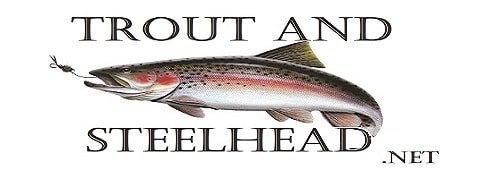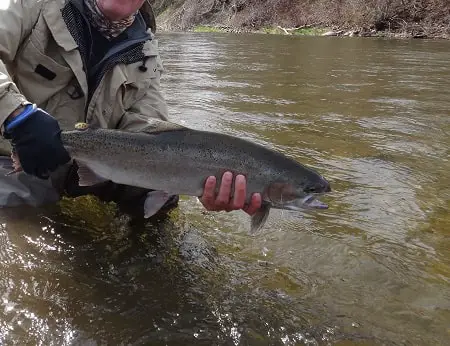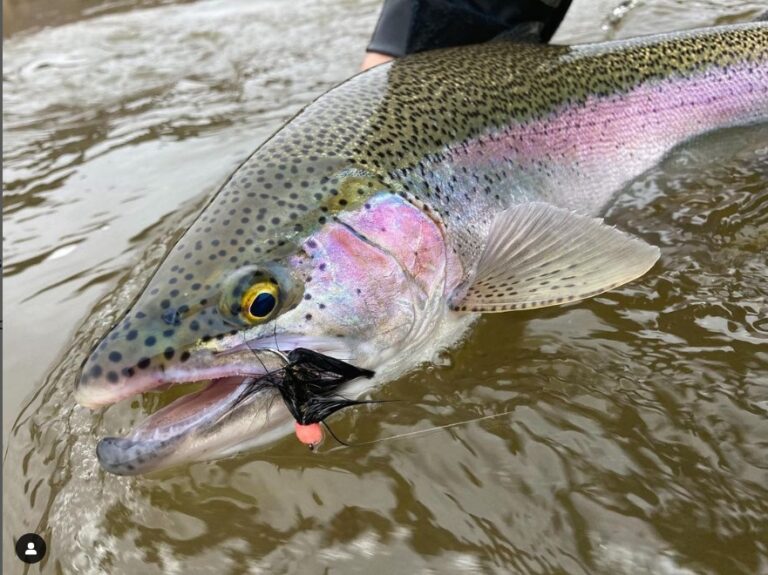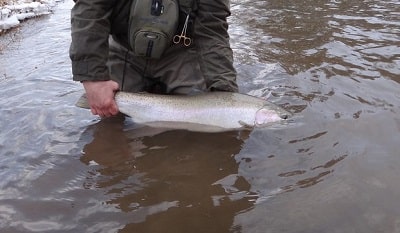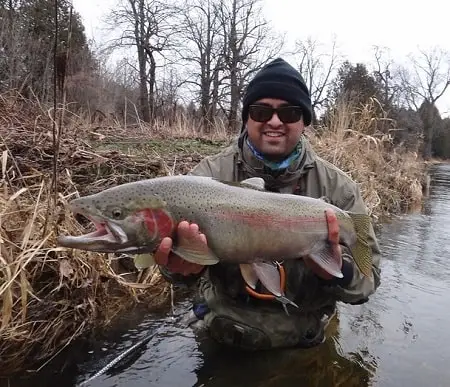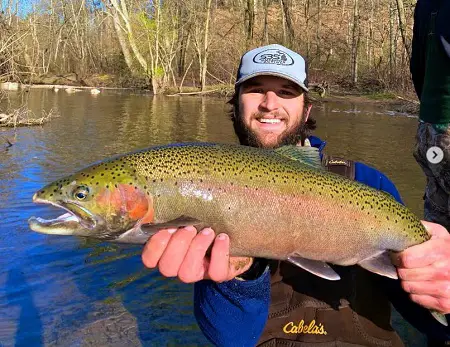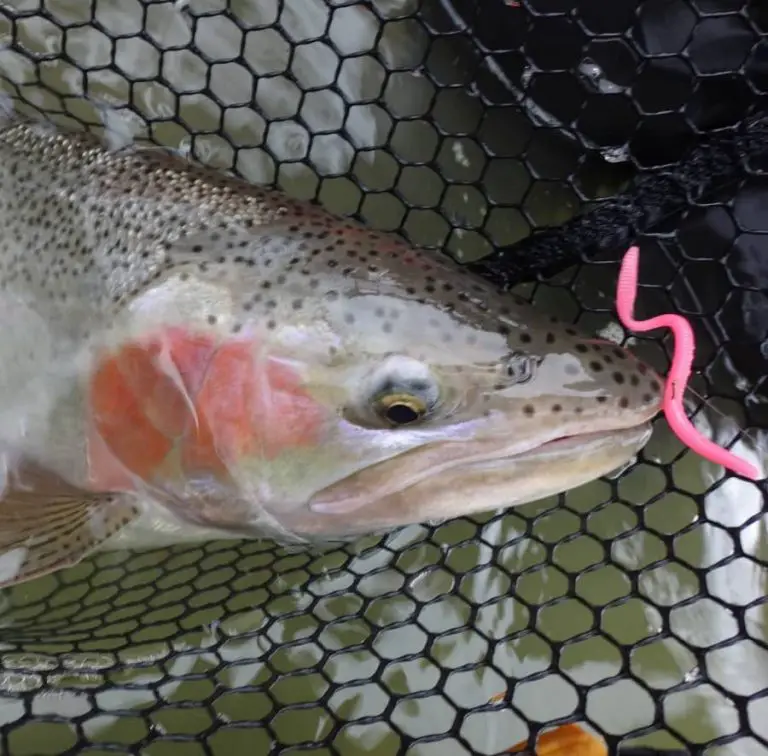Back Trolling For Steelhead: 5 Expert Tips For More Bites
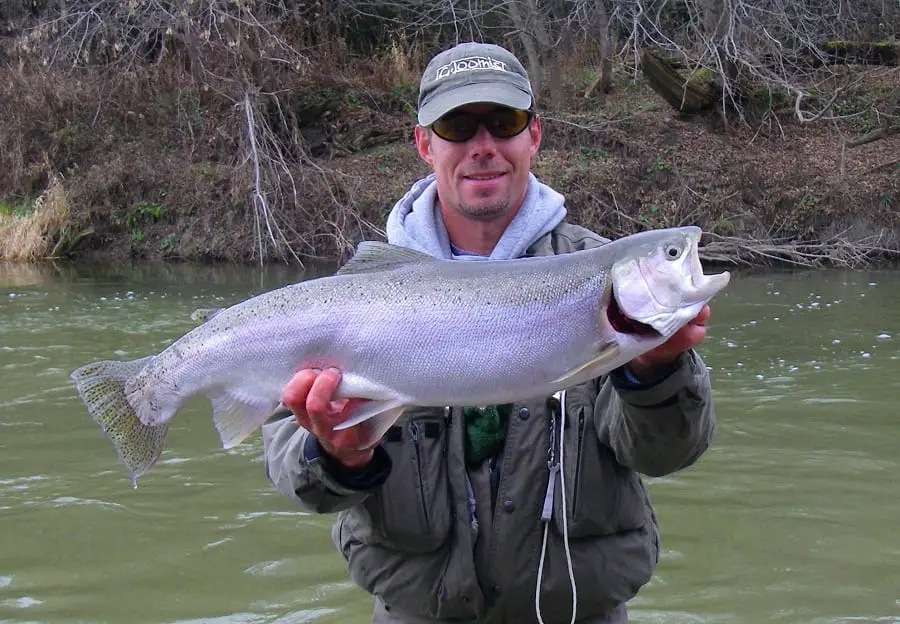
I have been back trolling for steelhead for over 20 years on some of the larger rivers and river mouths in my area, and it’s one of the many steelhead fishing methods I use when guiding.
This is a jam-packed article that includes three back trolling rigs.
I’ll discuss beginner and advanced tips and tactics that are used by experts so that you can catch more steelhead when back trolling. I’ll answer your question on things like which lures to use, when to use certain lures, and how much line to use.
Also, I’ll show you boat maneuvering patterns for covering the water.
What Is Back Trolling For Steelhead
Back trolling is a method used to present lures to steelhead from a boat in a controlled way while slowly backing the boat downstream. Back trolling for steelhead can be done on any steelhead river that is large enough and deep enough to get a boat into. Back trolling is also known to many river anglers as plug fishing for salmon.
The key component of back trolling and plug fishing for steelhead is to move slowly, take your time, put the plugs out the same distance, and use the same rods, same reels, same lines, and same setup so they all run the same and slowly back down the river.
Set the drag not too tight so the fish can take line when they hit, but wait before you set the hook, make sure the fish is hooked and taking line. And learn good boat control, pick your lines, and very slowly work the lures down into the fish.
This is not the same as Back Bouncing for steelhead.
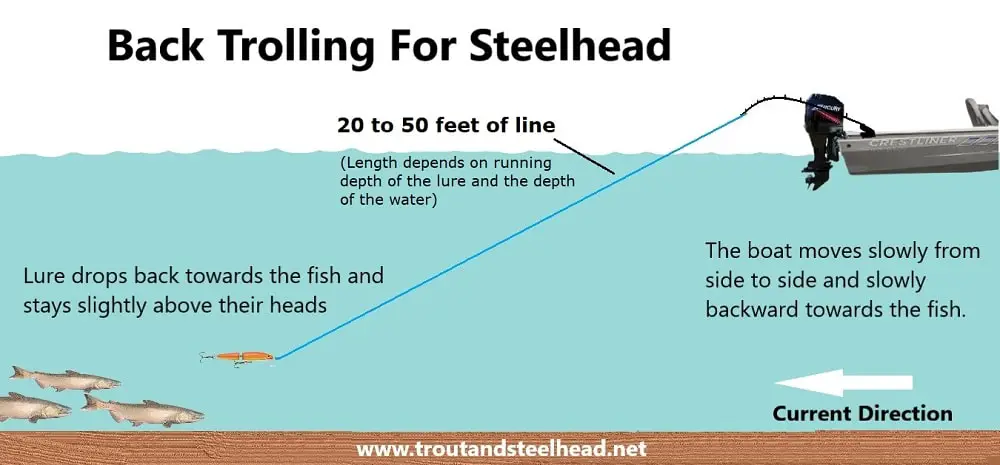
The method of back trolling is easy and effective if you have good boat control, understand lures and lure depth, and know where to fish. Back trolling is also very effective for salmon.
Back Trolling In A Boat
Anglers can back troll in just about any small to mid-sized fishing boat or from a drift boat, jet sled, pontoon boat, or raft. I have even seen fishermen back trolling from a fishing Kayak.
The key to back trolling in any boat is boat control. A skilled angler will know how to control the boat and keep it in position. They will also maneuver the boat in a way to get it to where the fish are, and control the speed so the boat descends downriver slightly slower than the current.
You can control the boat with a gas motor, an electric motor, oars, or the anchor.
Motor Boat
A gas-powered motorboat is great in both larger and smaller rivers. It enables the angler to hold the boat in position, slide it from side to side, or slowly move the boat and lure downstream.
Electric Trolling Motor – Auto-pilot electric motors on any boat enable the angler to quietly hold the boat in position and maneuver it side to side or slowly downriver.
Oars – Oars can be used and are used quite often to hold the boat in position or reposition the boat.
Drift Boats, Pontoon Boats, and Rafts
The advantage of a drift boat or inflatable boat is that they are portable, can get through very shallow water, and these river boats are stealthy. Anglers use oars or an anchor to keep the boat steady and in position. I have seen anglers mount an eclectic motor on these types of boats.
The Method Of Back Trolling For Steelhead
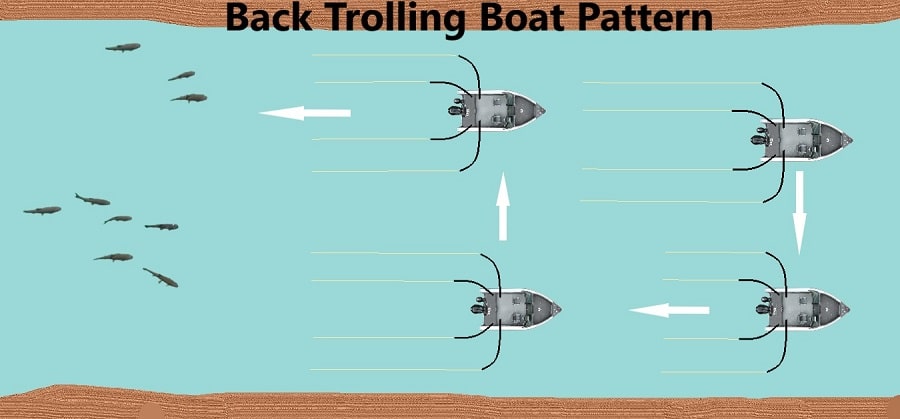
1. Achor and Hold – Get the boat in position far above where you think the fish are so that you can back your lure into the fish. Anchor or hold your position with the motor for this step.
2. Choose Lures and Line Length- Choose lures based on the depth of the spot and current speed, and use lures that will run 2 to 3 feet off the bottom, and then send out the lures to the desired length. The length of the line you set out depends on the desired depth, which I discuss below.
3. Ready The Rods – Put rods in the holder or hold them manually to prepare to fish.
4. Reposition Boat – Back the boat into position where the fish should be holding, and maneuver side to side on wider spots while holding the upriver position.
5. Drop Down – After a minute or two, drop the boat down 5 to 10 feet and repeat step 4.
When dropping the boat back in a wide river, I’ll use a side-to-side drop-down method or a slow, slight zig-zag pattern to cover the water more effectively.
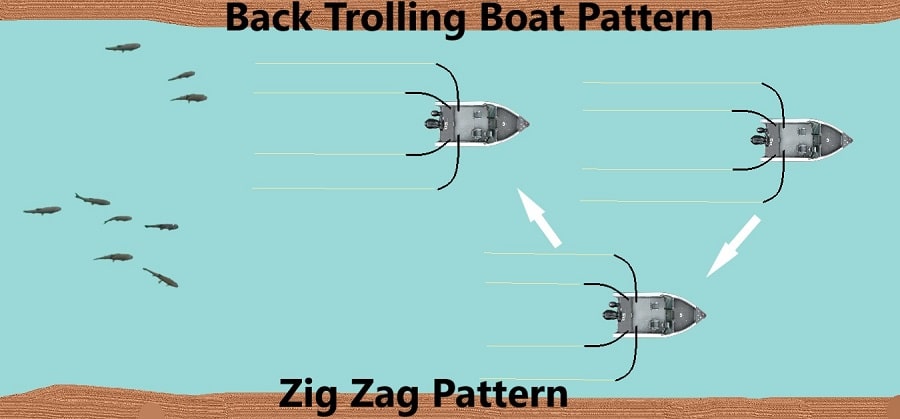
The Gear
Best Rods For Back Trolling – You can use any rod from 7 to 9 feet long rod, with the best rods being 7.5 to 9 feet long with medium stiffness, a softer light tip, and a line rating between 6 and 14 pounds.
The ideal steelhead backtrolling rods are:
- Lamiglas Battle Glass Salmon & Steelhead Casting Rod – the popular glass tip rod was built for back trolling and other methods.
- Lamiglas XCC Kwik Series Salmon & Steelhead Rod – The 9-foot medium-heavy is a multi-purpose trolling rod that is good for back trolling.
- St. Croix Onchor Salmon & Steelhead Trolling Rod – The 9-foot Medium-Heavy will work nicely even for large steelhead.
Reels – Line counter reels are great for determining the depth of your lure and the placement of the lure. You can also use a non-line counter, baitcaster reels, and spinning reels. Just make sure your reel spool holds a good amount of line and the reel has a smooth drag. See Best Reels For Steelhead.
Line – For the fishing line, you can use monofilament between 12 and 16 pounds, braided line between 20 and 50 pounds, or fluorocarbon between 14 and 20 pounds.
Leader – When using a mono or braided line, I will run a 12 to 16-pound fluorocarbon leader of 3 to 5 feet.
Rod Holders – Many anglers utilize rod holders, especially in areas where anglers are permitted to use 2 or 3 rods per person.
Terminal Tackle – You will need an in-line swivel and a snap swivel.
The Lures And Baits
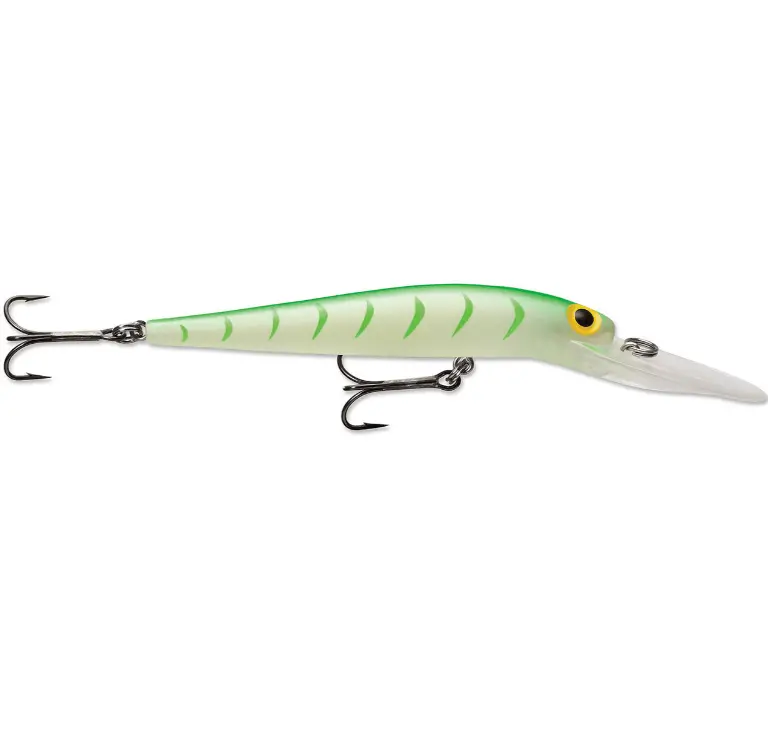
There are many lures that will work when you target steelhead, but there are only a few lures that excel with back bouncing.
Best Lure Colors – Before I discuss lures, with all of the recommended lures below, the best colors will depend on the river conditions, which means height, clarity, and even current speed.
Therefore, it’s best to have a couple of lures in darker colors like purple or black, a couple of flashy lures like silver, silver/blue, silver/green, and also a couple of bright-colored lures in orange or chartreuse. Pink and white also have their time and place.
Lure Sizes: The best lures are usually 3 to 4 inches. Stick in this range for most river conditions. In higher, dirtier water, large plugs and 5-inch lures work better.
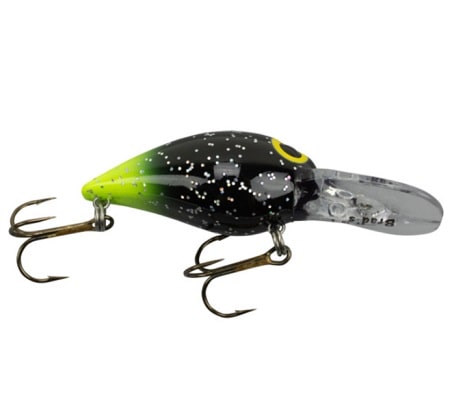
Crankbaits – Crankbaits like deep diving or mid-depth Rapalas are effective.
Many anglers, myself included, like lures like Luhr Jenson Hot Shots, Brad’s Wigglers, or Strom Wiggle Warts with rattles that get the attention of the steelhead.
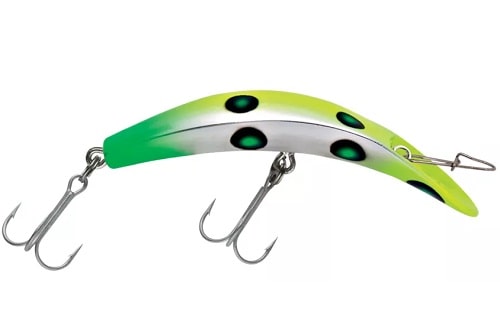
Plugs – Back trolling plugs for steelhead is probably the most popular method because the wobbling plugs have a lot of action that drive steelhead crazy.
Best plugs include Kwickfish K12 to K14, Flat Fish, Mag Lips, and Lymans.
Spoons and Spinners: Spoons and spinners are not used as much since they sink. See Best Lures For Steelhead.
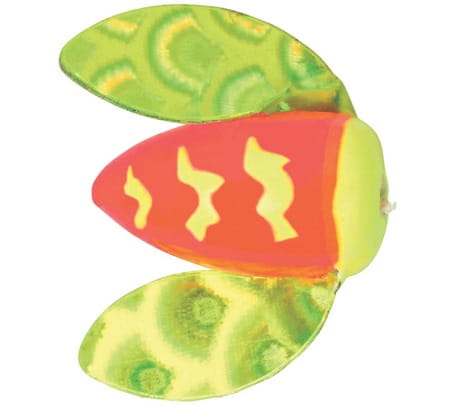
Guide Tip: Many guides and anglers will use scent on their lures, or will wrap cut-bait pieces of herring, anchovy, tuna, coon shrimp, or sand shrimp to their plugs to create a scent that can trigger more bites.
Spin-N-Glo and Bait: At times, especially in clear water, using a Spin-N-Glo with a bait like a Coon-Shrimp or prawn will work really well.
Which Lure and When
Plug fishing and crankbait fishing can work equally well most of the year and in any conditions. For me, it’s generally always trial and error, and often, when running multiple rods, I will run a mix of plugs and crankbaits to try to determine what the steelhead prefers.
In icy cold water and stubborn fish, I tend to do better with wobbling plugs like Kwikfish.
Plug Tuning and Fishing
A guide tip is to check and tune your lure before you put it in the water and after you have caught a fish.
Simply hold it over the side of the boat in a foot or two of water and see how it runs. If it’s not running properly, bend and adjust the eye of the lure slightly to get it to run straight.
Rod Holder or Hand?
The question of whether you should put your rod in a rod holder or hold the rod in your hand comes up often. My short answer is that it is always best to hold the rod in your hand.
The primary advantage of holding the rod in your hand is to be able to quickly feel fish strikes and then set the hook fast. The other advantage that I find is periodically pulling, ripping, and twitching the lure, which increases bites for me, and this is best done if you’re holding the rod.
However, holding the rod in your hand is not always possible. If you are running multiple rods per person or you are busy steering the boat or using the oars, a rod holder is mandatory.
Where to Fish Plugs And Lures For Steelhead
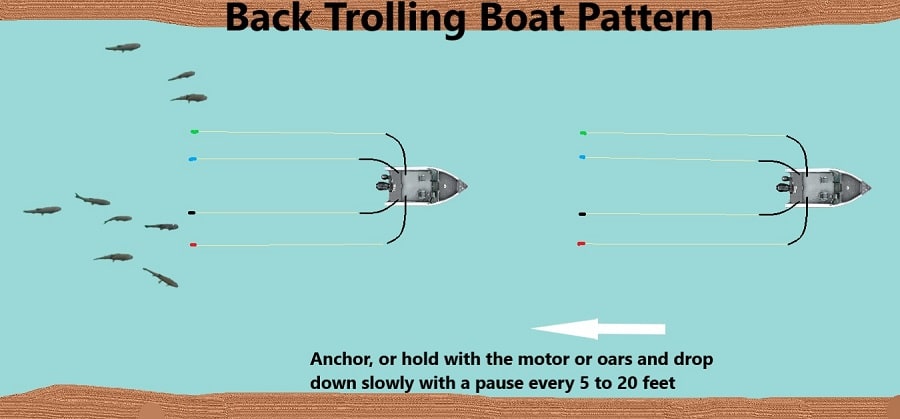
In my experience, steelhead almost always gravitate to deeper water. This means the most productive water is in deeper trenches and larger deep holes.
Steelhead run rivers, and when they do, they tend to use what I call travel routes. Most steelhead rivers have these travel routes, and they can often be identified as areas with a combination of current and depth.
Prime steelhead water to fish is travel routes, areas below shallows and rapids, long, deep corner pools, and beside deep structures.
Winter steelhead tend to hold in deeper water in the middle or tail outs of bigger pools. This is where a slow-wobbling deep-diving plug can be hot.
Guide Tip: When the water is high and fast, your normal fishing holes might be too fast for the steelhead to hold. Instead, look for seams or slower water beside the faster water, or other slower water areas.
8. Back Trolling Guide Tips For More Fish
1. Twitch, Rip, Pull – Sometimes, the steelhead will follow and look at the lure, but not bite it because it is stationary and not running from the steelhead. You can often trigger a bite by pulling or reeling up line 3 to 8 feet quickly. Also, pumping the rod or using a rip-twitch rod action can trigger a strike. I do this before I move or drop down.
2. Sharp Hooks: Often, the rods are in the holders, so the fish grab and turn and hopefully set the hook on themselves, but if you are going to lose fish, it’s when you pull the rod out of the rod holder. Having razor-sharp hooks means more securely hooked fish and fewer lost fish.
3. Know Your Lure Depth: This is where anglers struggle. You’re lure will tell you if it’s too deep, but it won’t tell you if it’s too high.
When trolling plugs for steelhead or using crankbaits, if your rod tip is pulsating, your lure is wobbling and running properly above the bottom. If the rod tip stops pulsating, or if it starts and stops on and off, your lure is either bumping the bottom or is fouled with debris. If the lure is bumping bottom, make the line shorter or run a higher running lure.
4. Length of Line Out: If you are not sure of the depth of the river or the running depth of your lure, remember this. If it’s shallower, the length of the line you let out will be less, so that the lure doesn’t dive so deep.
If it’s deep water, you may need to let more line out to get the lures running deeper or use a diver setup.
5. Spread Them Out: I will use shorter rods on the inside and longer rods for the outside lures. I will also angle the rods differently, as seen in the above diagram.
6. Keep Them Even: When running 2 to 4 lures at a time, try to run all your lures at the same distance. If you are using a spinning reel, you can use a portable line counter that goes on your rod blank to help you gauge the amount of line going out.
You can also look to see that all the lines enter the water at the same spot with the same rod height. This is not 100 percent accurate, but it is close.
7. Setting the Drag: Although you are running 40-pound line, you want to set the drag light enough that the fish can pull the line out.
This does two things. It allows the fish to turn downstream with the plug, which sets the hook in the corner of the mouth. It also gets the fish downstream and farther away from the other plugs, so they are less likely to tangle.
8. Chain Anchor – Having an anchor that is made entirely out of a thick, heavy chain allows the angler to lift part of the anchor up and drag the rest, which allows the boat to slowly move down the river without it getting caught up.
9. Electric Anchor – An electric anchor means your hands are free to fish and steer the boat or use the oars. It also keeps your hands dry and warmer in the winter.
3 Best Back Trolling Rigs For Steelhead
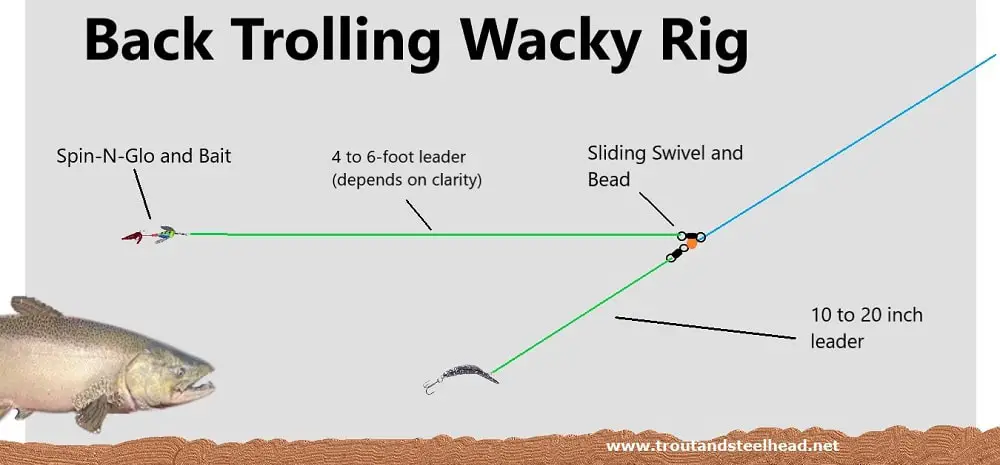
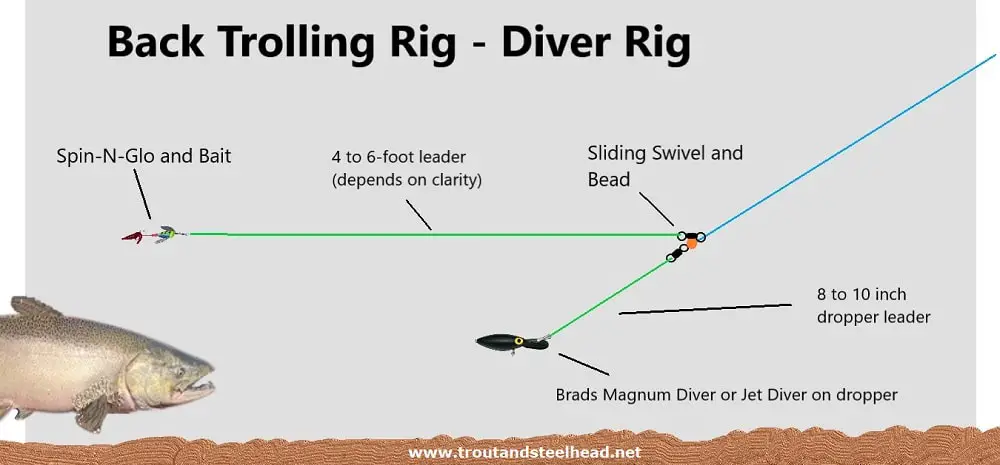
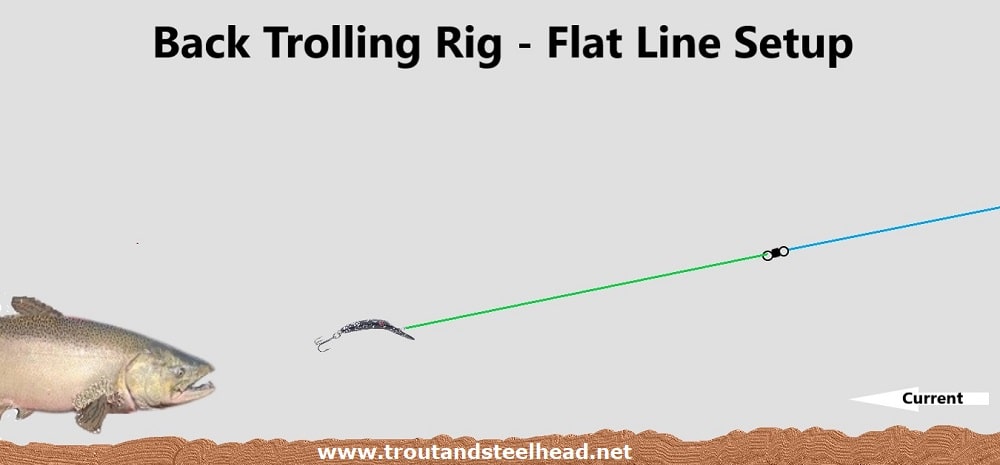
Back Trolling For Steelhead Q&A
If you have a question or comment, or would like to share your tips on back trolling for steelhead, let us know in the comments below.
Tight Lines
Graham
